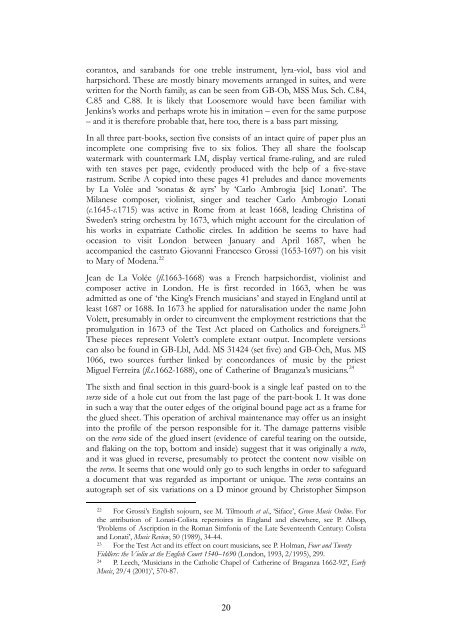Ne irascaris, Domine - The Viola da Gamba Society
Ne irascaris, Domine - The Viola da Gamba Society
Ne irascaris, Domine - The Viola da Gamba Society
Create successful ePaper yourself
Turn your PDF publications into a flip-book with our unique Google optimized e-Paper software.
corantos, and sarabands for one treble instrument, lyra-viol, bass viol and<br />
harpsichord. <strong>The</strong>se are mostly binary movements arranged in suites, and were<br />
written for the North family, as can be seen from GB-Ob, MSS Mus. Sch. C.84,<br />
C.85 and C.88. It is likely that Loosemore would have been familiar with<br />
Jenkins’s works and perhaps wrote his in imitation – even for the same purpose<br />
– and it is therefore probable that, here too, there is a bass part missing.<br />
In all three part-books, section five consists of an intact quire of paper plus an<br />
incomplete one comprising five to six folios. <strong>The</strong>y all share the foolscap<br />
watermark with countermark LM, display vertical frame-ruling, and are ruled<br />
with ten staves per page, evidently produced with the help of a five-stave<br />
rastrum. Scribe A copied into these pages 41 preludes and <strong>da</strong>nce movements<br />
by La Volée and ‘sonatas & ayrs’ by ‘Carlo Ambrogia [sic] Lonati’. <strong>The</strong><br />
Milanese composer, violinist, singer and teacher Carlo Ambrogio Lonati<br />
(c.1645-c.1715) was active in Rome from at least 1668, leading Christina of<br />
Sweden’s string orchestra by 1673, which might account for the circulation of<br />
his works in expatriate Catholic circles. In addition he seems to have had<br />
occasion to visit London between January and April 1687, when he<br />
accompanied the castrato Giovanni Francesco Grossi (1653-1697) on his visit<br />
to Mary of Modena. 22<br />
Jean de La Volée (fl.1663-1668) was a French harpsichordist, violinist and<br />
composer active in London. He is first recorded in 1663, when he was<br />
admitted as one of ‘the King’s French musicians’ and stayed in England until at<br />
least 1687 or 1688. In 1673 he applied for naturalisation under the name John<br />
Volett, presumably in order to circumvent the employment restrictions that the<br />
promulgation in 1673 of the Test Act placed on Catholics and foreigners. 23<br />
<strong>The</strong>se pieces represent Volett’s complete extant output. Incomplete versions<br />
can also be found in GB-Lbl, Add. MS 31424 (set five) and GB-Och, Mus. MS<br />
1066, two sources further linked by concor<strong>da</strong>nces of music by the priest<br />
Miguel Ferreira (fl.c.1662-1688), one of Catherine of Braganza’s musicians. 24<br />
<strong>The</strong> sixth and final section in this guard-book is a single leaf pasted on to the<br />
verso side of a hole cut out from the last page of the part-book I. It was done<br />
in such a way that the outer edges of the original bound page act as a frame for<br />
the glued sheet. This operation of archival maintenance may offer us an insight<br />
into the profile of the person responsible for it. <strong>The</strong> <strong>da</strong>mage patterns visible<br />
on the verso side of the glued insert (evidence of careful tearing on the outside,<br />
and flaking on the top, bottom and inside) suggest that it was originally a recto,<br />
and it was glued in reverse, presumably to protect the content now visible on<br />
the verso. It seems that one would only go to such lengths in order to safeguard<br />
a document that was regarded as important or unique. <strong>The</strong> verso contains an<br />
autograph set of six variations on a D minor ground by Christopher Simpson<br />
22 For Grossi’s English sojourn, see M. Tilmouth et al., ‘Siface’, Grove Music Online. For<br />
the attribution of Lonati-Colista repertoires in England and elsewhere, see P. Allsop,<br />
‘Problems of Ascription in the Roman Simfonia of the Late Seventeenth Century: Colista<br />
and Lonati’, Music Review, 50 (1989), 34-44.<br />
23 For the Test Act and its effect on court musicians, see P. Holman, Four and Twenty<br />
Fiddlers: the Violin at the English Court 1540–1690 (London, 1993, 2/1995), 299.<br />
24 P. Leech, ‘Musicians in the Catholic Chapel of Catherine of Braganza 1662-92’, Early<br />
Music, 29/4 (2001)’, 570-87.<br />
20

















